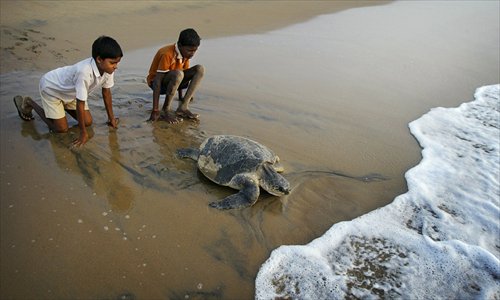Turtle disaster

Coastal erosion and climate change have forced hundreds of thousands of endangered olive ridley marine turtles to skip this breeding season at Odisha's Gahirmatha beach, one of their favorite destinations for mass nesting.
Named after their olive-colored, heart-shaped shell, these Pacific turtles migrate thousands of miles in the Indian Ocean for mating and nesting. Gahirmatha beach drew international attention after its discovery in 1974 by American zoologist Dr H R Bustard. For centuries, the beach has hosted the world's most spectacular arribada, the Spanish word for "arrival by sea" that is used to describe arrival of turtles en masse. Last season, more than 200,000 turtles visited this beach in a single night.
The marine turtles routinely visit the coast during October-November to mate, while annual mass nesting usually takes place between January and March each year.
However, the event has not occurred this year even though the season is almost at its end.
Human interference
In order to offer a peaceful atmosphere for the turtles, a ban on fishing within 20 kilometers of the coast was imposed from November 1, 2013, till the end of May 2014.
The ban is to restrict the local fishing community but "the turtles are in trouble due to the frequent and illegal movement of trawlers in the prohibited area," said a local volunteer.
Apart from fishing, regular missile tests by the Indian Defence Ministry's DRDO (Defence Research and Development Organisation) during turtle breeding seasons are also believed to have affected migration.
"Despite requests from the government to restrain from testing missiles during turtle breeding seasons, test firing is conducted. This seems to be an act of irresponsibility from the DRDO," Biswajit Mohanty, a known turtle conservator and noted wildlife activist, told the Global Times.
Since November 2013, at least four tests have been carried out by the DRDO at Wheeler Island, which is close to the turtle nesting site. The last of the tests took place on April 11. It has been reported that the DRDO has plans to carry out more than a dozen such tests during the next 45 days, throughout the turtle breeding season that extends up to May 31.
Apart from the missile tests, operational activities at Dhamra Port are also thought to be disturbing the turtles. However, the negative impact of the port on the annual breeding activities of turtles was known in the port's planning period. In fact, project works for the port at the mouth of the Dhamra River were delayed for about a decade.
If wildlife officials at the forest department are to be believed, Gahirmatha still waits for the turtles to visit the beach to nest as the event has previously taken place during the latter part of April.
"Unusual rain during the peak nesting season might have played deterrent to the annual breeding activity of the turtles. But, huge numbers of female turtles are still in the river mouth and the coastal sea. As the event of mass nesting has taken place late in April in many past years, we still hope that it may be the same this year too," Kedar Kumar Swain, the Divisional Forest Officer of Rajnagar Mangrove Forest Division, told the Global Times.
However, apprehension that the turtles may skip the annual activity this year rather grows stronger with every passing day.
Same fate as Costa Rica?
To nature conservationists and wildlife experts, the turtles are deprived of the space they require because rapid coastal erosion and frequent high tides have geographically deformed and shrunk the beach they nest on.
"Erosion at an alarming scale is the biggest threat to the beach and the marine species that travel so long in the ocean to reach their favorite ground for nesting. If the trend continues, the turtles may have no other option but to abandon the beach and look for other destinations," Jivan Das, an activist involved with India's leading animal welfare body - People for Animals - told the Global Times.
"Remarkable changes in climate are also a factor behind making the beach unsuitable for nesting activity," Das added.
"Unusual rain in the peak nesting season, frequent high tides and variation in coastal temperature are some of the indicators of climate change that might have disturbed the balance of moisture in the air and sand, which is an essential factor to keep the beach conducive for nesting of turtles," Dr Rahas Bihari Panda of Department of Environmental Science, North Odisha, told the Global Times.
"The delay in the activity of the turtles may also be attributed to El Nino. As scientists have predicted about the possible impacts of the phenomenon over Indian weather, the marine reptiles might have sensed it early from the transportation of heat by sea currents," Dr Panda said.
Looking at the recent trend with Costa Rica's national parks, host to nesting activity of the critically endangered hawksbill sea turtle, coastal erosion and climate change has forced the turtles to change their migration route. It's not absurd to imagine a similar fate for the Gahirmatha nesting beach.
But the question is, if they skip Gahitmatha, is it just for this year or forever?